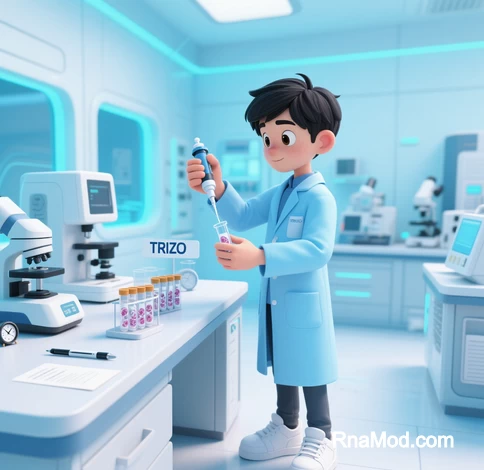 I. Foundational Principles of TRIzol Chemistry
I. Foundational Principles of TRIzol Chemistry
TRIzol reagent employs a triphasic chemical system to isolate intact RNA through sequential dissociation of cellular components:
- Cellular Disruption:
- Guanidinium thiocyanate denatures proteins and inactivates RNases
- Acidic phenol lyses cells while maintaining RNA stability at pH 4.0
- Phase Separation:
- Chlorform addition creates:
- Organic phase (proteins/lipids)
- Interphase (DNA)
- Aqueous phase (RNA)
- RNA Precipitation:
- Isopropanol dehydrates RNA molecules
- Ethanol washes remove residual salts
(Fig. 1: TRIzol Phase Separation Mechanism)
Description: Diagram showing triphasic separation after centrifugation: red organic phase (bottom), white interphase, clear aqueous phase (top) containing RNA. Arrows indicate targeted RNA extraction from aqueous layer.
II. Step-by-Step Extraction Protocol
A. Sample Preparation
| Sample Type | TRIzol Volume | Processing Method |
|---|---|---|
| Cultured Cells | 1 ml per 10⁷ cells | Direct lysis in culture dish |
| Animal Tissue | 1 ml per 100 mg | Liquid N₂ grinding |
| Plant Material | 1 ml per 50 mg | Mortar/pestle homogenization |
| Blood/Biofluids | 0.75 ml per 0.25 ml | Vortex homogenization |
Critical Precaution: Perform all steps in RNase-free environment with chilled equipment (#)
B. Phase Separation Workflow
1. **Homogenization**:
- Vortex sample/TRIzol mixture 30 sec
- Incubate 5 min at 15-30°C (#)
2. **Organic Extraction**:
- Add 0.2 ml chloroform per 1 ml TRIzol
- Shake vigorously 15 sec → incubate 3 min (#)
3. **Centrifugation**:
- 12,000g at 4°C for 15 min
- Aqueous phase volume = \~60% of TRIzol used (#)
(Fig. 2: Phase Separation Visual Guide)
Description: Centrifuge tube showing distinct layers post-spin with pipette extracting clear aqueous phase. Red “X” marks indicate prohibited interphase contact.
C. RNA Precipitation & Purification
1. **Isopropanol Precipitation**:
- Transfer aqueous phase to new tube
- Add 0.5 ml isopropanol per 1 ml TRIzol
- Incubate 10 min at -20°C (#)
2. **Pellet Formation**:
- Centrifuge 12,000g at 4°C for 10 min
- Discard supernatant (pellet visible at tube bottom) (#)
3. **Ethanol Wash**:
- Add 1 ml 75% ethanol (in DEPC-H₂O)
- Vortex gently → centrifuge 7,500g for 5 min
- Repeat wash (#)
4. **RNA Resuspension**:
- Air-dry pellet 5-10 min (avoid overdrying)
- Dissolve in 20-50 µl RNase-free H₂O
- Incubate 10 min at 55°C (#)
III. Quality Control Metrics
A. Spectrophotometric Analysis
| Parameter | Optimal Value | Interpretation |
|---|---|---|
| A260/A280 | 1.8-2.0 | Pure RNA (protein-free) |
| A260/A230 | >2.0 | Low organic/inorganic contaminants |
| RNA Yield | 5-15 µg per 10⁶ cells | Extraction efficiency |
B. Integrity Verification
- Gel Electrophoresis:
- Sharp 28S and 18S rRNA bands (2:1 intensity ratio)
- Minimal smearing below 18S (#)
- Bioanalyzer:
- RNA Integrity Number (RIN) >7.0
(Fig. 3: RNA Quality Assessment)
Description: Agarose gel image showing intact RNA samples (sharp 28S/18S bands) vs. degraded RNA (smear pattern). Nanodrop screen displaying A260/280 ratio of 1.92.
IV. Troubleshooting Guide
| Problem | Root Cause | Solution |
|---|---|---|
| Low Yield | Incomplete homogenization | Pre-grind fibrous tissues in liquid N₂ |
| Protein Contamination | Inadequate phase separation | Increase chloroform volume by 25% |
| DNA Contamination | Interphase disturbance | Leave 2 mm clearance above interphase |
| RNA Degradation | RNase contamination | Treat surfaces with RNaseZap® |
| Poor Solubility | Pellet overdrying | Reduce air-drying time to 5 min |
V. Specialized Applications
A. Plant RNA Extraction
- Modification:
- Add 2% β-mercaptoethanol to TRIzol
- Perform double chloroform extraction
- Polysaccharide Removal:
- Add 0.3M sodium acetate (pH 5.2) before isopropanol
B. Concurrent Protein Extraction
- Organic Phase Processing:
- Add 3 volumes ethanol to organic phase
- Centrifuge → wash protein pellet with 0.1M citrate
- DNA Recovery:
- Mix interphase with 0.1M citrate/ethanol
- Centrifuge → dissolve DNA in 8mM NaOH
VI. Safety & Storage Protocols
A. Hazard Management
- TRIzol: Corrosive – use nitrile gloves/eye protection
- Chloroform: Carcinogen – handle in fume hood
- Ethidium Bromide: Mutagen – use SYBR® Safe alternatives
B. Sample Preservation
| Form | Storage | Stability |
|---|---|---|
| Tissue in TRIzol | -80°C | 12 months |
| RNA in ethanol | -80°C | Indefinite |
| Aqueous RNA | -80°C | 6 months |
“TRIzol remains the gold standard for RNA extraction because it converts complex cellular architecture into discrete molecular fractions through elegantly orchestrated chemistry.”
— Nature Methods Technical Review, 2025
Data sourced from publicly available references. For collaboration or domain acquisition inquiries, contact: chuanchuan810@gmail.com.
